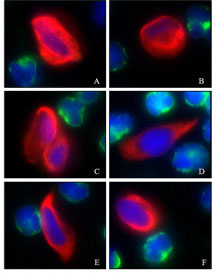

Scientists Illuminate Structure of Circulating Lung Cancer Cells
By Eric Sauter and Mika Ono
Most cancer-related deaths are caused by metastases—the spread of cancer to other parts of the body—and tumor cells that circulate in the bloodstream are generally understood to be the cause of these dangerous secondary tumors. Now, for the first time, a collaboration led by scientists from The Scripps Research Institute has been able to determine the structural features of circulating tumor cells, which were collected from the blood of a woman with advanced lung cancer.
The ability to detect and characterize these cells may provide new insight into their metastatic potential, and could also result in advances in the diagnosis, treatment, and management of the disease.
The study, which was conducted in collaboration with members of the Scripps Clinic, The Palo Alto Research Center, and the Billings Clinic (Montana), was published as the cover article in the September 2009 edition (Volume 133, Issue 9) of the journal Archives of Pathology and Laboratory Medicine, a major clinical journal published by the College of American Pathologists.
"This study is a breakthrough," said team leader Peter Kuhn, a Scripps Research associate professor in the department of Cell Biology. "We were able to find these cells and image them so clearly that they can be used as clinical biopsy material. We didn't just count them—we were able to interpret them."
Most current technologies for identifying cancer cells in the bloodstream do not allow for preservation of much cell detail, and published descriptions of the cell structure and images of tumor cells retrieved from the bloodstream are virtually nonexistent.
"In fact, I know of no existing detailed descriptions of lung cancer circulating tumor cells at all," said Kuhn. "So this really is a significant achievement in validating a blood sample biopsy."
Novel Methodology
To uncover the structure of these circulating tumor cells, Kuhn used a previously published methodology called fiber optic array scanning technology or FAST. Kuhn and his laboratory colleagues developed the basic technology in 2004.
"That earlier study published in Human Pathology, which was done on breast cancer, established for first time that the cells we found in circulation were very similar to the cell types in the primary tumor," he said. "Now we have shown similar findings for lung cancer for the first time—but with far better results."
In the new study, Kuhn and his colleagues determined the cytomorphology of circulating tumor cells four years after the patient was diagnosed with her disease. The scientists identified some 67 circulating tumor cells in blood samples. When compared with the original tissue biopsy, there were a striking number of similar features between the circulating tumor cells and the biopsy cells, including a large size in comparison to standard white blood cells.
Kelly Bethel, a pathologist with the Scripps Clinic and adjunct professor at Scripps Research who worked on the study, noted, "Because the patient's cancer cells partially resemble benign lung cells but are in the abnormal location of the bloodstream, they are quite distinct, and because our imagery is so sharp, we could compare the circulating tumor cells to primary biopsy cells quite easily. The next challenge is to see if we can characterize how the appearance and structure of these circulating tumor cells change over time and with treatment."
Circulating tumor cell detection and characterization could aid in the development of individualized treatment strategies, Kuhn suggested, and a number of publications have already described the impact of the number (or change in number) of detectable circulating tumor cells on patient response to therapy.
"This is the first time that our work has been recognized by a major clinical audience, the people who do this work for real," said Kuhn. "This represents a huge step forward for us in terms of their acceptance and opens the door to potential applications of our approach."
The first author of the study, titled "Circulating Tumor Cells from Well-Differentiated Lung Adenocarcinoma Retain Cytomorphologic Features of Primary Tumor Type," is Dena Marrinucci of Scripps Research. In addition to Kuhn and Bethel, other authors include Madelyn Luttgen of Scripps Research; Richard Bruce of The Palo Alto Research Center; and Jorge Nieva of the Billings Clinic (Montana). For more information, see http://arpa.allenpress.com/arpaonline/?request=get-abstract&doi=10.1043%2F1543-2165-133.9.1468.
Additional imagery and follow up data can be found at http://cancer.scripps.edu.
The study was supported by the National Institutes of Health.
Send comments to: mikaono[at]scripps.edu

The ability to detect and characterize circulating
tumor cells (as shown here) may provide new insight into their potential to
establish dangerous secondary tumors, and could result in advances in cancer
diagnosis, treatment, and management.
